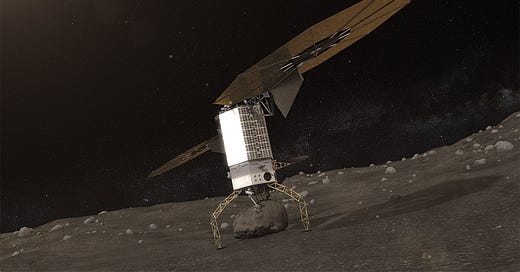The first asteroid mining gold rush died in 2017.
Now @ForgeAstro are leading a new charge for asteroid mining this decade.
Back in 2012, there was a mini-boom in asteroid mining, with two companies leading the charge, Planetary Resources and Deep Space Industries (DSI).
Neither company is still around, having both been acquired after running into financial difficulties around 2017. Interestingly, Planetary Resources was acquired by Consensys, the blockchain company, for reasons that were never entirely clear…
Anyway, before we get to what went wrong, let's consider why you might want to mine asteroids in the first place?
Asteroids are small rocks, left over from when the solar system was formed about 4.6bn years ago, that never quite turned into a full planet. By small, I mean they can be anywhere from 10 metres wide to hundreds of kilometres.
There are quite a lot of them in our solar system, with over a million tracked so far.
Some of these astroids are made up of minerals that are rare on Earth such as gold, silver, platinum, copper, indium, lead and palladium.
Thats why NASA estimates that the asteroid belt between Mars and Jupiter could be worth around 700 quintillion dollars.
Platinum and other rare earth elements in particular, form a critical part of many electronics devices such as cell phones, computers that we are building in greater quantities every year. The challenge of course is that these elements are quite rare on Earth, hence the name, and mining these elements is also a massively environmentally destructive process.
Accessing the functionally infinite store of minerals on asteroids could help transition away from harmful mining operations on Earth.
So the potential rewards to asteroid mining are huge, there's just the minor technical hurdle of these riches being located in a chunk of rock hurtling through space.
With so much at stake, what when wrong for Planetary Resources and DSI?
It’s hard to disentangle a singular cause, but one theory is that they failed because they didn’t build any intermediate products, i.e. products they could sell along the way to ensure they stayed in business. Making commercial use of the technologies they were developing would have provided revenue, and given the companies a chance at getting to the larger and more ambitous goal of mining the asteroids.
Also their focus was on harvesting water, with the idea being to sell it as a propellant for space fuel stations. At the time, there wasn’t much demand for space fuel stations, so it might be they were a little ahead of their time.
In contrast, Astro Forge are focussing on platinum, which currently retails for around $31,000 per kg. This makes the more immediate commercial opportunity clearer, there is already a high and growing demand for platinum, whereas the demand for space fuel is a little more uncertain.
Another change is that getting to space is getting cheaper, with the cost per kg on a SpaceX Falcon Heavy being $1400 per kg. That around 700 times cheaper than Vanguard, the first family of Nasa’s rockets, and 44 times cheaper than the Space Shuttle programme.
As the cost to go to space gets cheaper, it gets less risky to try ambitious projects like asteroid mining.
It is worth noting, that despite my excitement, only one mission has ever successfully returned a sample from an asteroid. That was done by the Japan Aerospace Exploration Agency (JAXA) in 2010, and the amount was quite small, just a few micrograms of dust!
So we still have a long way to go before we are shipping meaningful quantities of rare metals back to Earth.
Astro Forge want to bring hundreds of kilograms back to Earth. This is still an enormous step up.
For another comparison, NASA's OSIRIS-Rex mission is aiming to bring back about 1kg of unrefined material, and that mission is going to cost $800m. @Forgeastro have so far raised $13m.
With that money they want to launch a small craft to an asteroid near to Earth, refine some minerals, and send it back to Earth. And they want to do that for less than $10m.
If they succeed it would be a remarkable technological achievement, and a huge milestone in space exploration.
So called ‘In situ resource utilisation’ means using the resources of space in space, rather than bringing resources from Earth. Developing the skills, technology and infrastructure necessary to make asteroid mining feasible will be critical step to building Mars bases, for example.
Jose Acain and Matt Gialich, the cofounders of Astro Forge, think that space has actually become a bit boring recently (!), with companies starting either camera companies looking at Earth, or launch vehicle companies. They want to inspire the next generation to dream bigger, which is a goal I will always get behind.
Astro Forge are planning their first mission for January next year, where they will demonstrate their proprietary technology which apparently enables them to refine the material in space and return only the highest value resources that are immediately ready to sell. They aren’t giving away too much more about this technology at the moment, but it will be exciting to see what it looks like when it goes to space in 2023.
Even if Astro Forge ultimately don’t succeed in their mission, the riches and challenge of mining asteroids will continue to attract those who are ambitious and crazy enough. And their work takes the baton one step further towards humanity’s multi-planet future.
Let me know what you thought of today’s glimpse into the future by clicking the feedback below, or hit reply and say hi.
Until next time
Ad astra
Jamie
Did you enjoy this week's newsletter? Help me to improve!
Click on a link to vote:
Thanks for your feedback!






